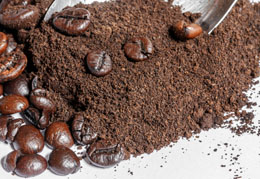Using coffee grounds for plants is quite popular mainly because of their high nitrogen content and ability to repel pests. You can add their extract directly to the plants or use them in the composting process.

The wide usage of tea and coffee as beverages is known all over the world. With such popularity, it is understandable that tea and coffee is brewed in most households everyday. Not many of us think twice before throwing the wet remains of coffee grounds and tea bags into the trash. However, both these leftovers can be used for various purposes.
Coffee grounds can be recycled to make eco-friendly dyes, insect repellents, for formulating cleaning products, for flea treatments in dogs, and also for composting. Using coffee grounds for plants is highly popular among gardening hobbyists and plant enthusiasts. When added correctly, they benefit garden plants in several ways.
Tips on Using Coffee Grounds
Besides fallen plant leaves, twigs, branches, and cut lawn grasses, you can add coffee grounds and tea bags into your compost bin as well. These wet components are broken down rapidly and help in balancing the nitrogen content of the final compost. Excellent results are seen when coffee grounds are used for acid-loving plants such as hydrangeas, gardenia, and roses. They enrich the soil with nutrients and regulate the acidity of the soil medium.
- Coffee grounds are a rich source of nitrogen for all types of plants. You can simply add the leftover grounds along with the other ingredients while preparing the potting media used for growing new plants. For garden plantations, mix them with the garden soil.
- Before watering, or before the arrival of rains, supplement the planting medium with used grounds. As these are soaked by water, they serve as a slow release nitrogen fertilizer for the plants.
- Another benefit of this compost is repelling insects and pests that accumulate at the base of the plants. Sprinkling wet grounds in this area drives away not only pests, but also kittens and cats who prefer playing near plants.
- You can make a mild liquid fertilizer with spent coffee grounds. Mix ½ pound of the grounds and 5 gallons of water in a large plastic bucket. Allow the mixture to settle down and use it on potted plants and garden flowers.
- If you are into vermicomposting, you can add small doses of these grounds for feeding worms at regular intervals. Do not add in large amounts, as they can affect the moisture balance and acidity of the compost medium.
- Some hobbyists are of the opinion that an excess of these grounds affects the plants negatively, as they form clumps under moist conditions. This in turn can deprive the root system of oxygen. Thus, always make sure that you add an appropriate concentration of the grounds to plants.
Using coffee grounds is a healthy way to recycle waste and benefit garden plants with essential plant nutrients. They help boost fruit formation (in plants like tomato) with nitrogen enrichment, and also prevent the onset of late blight disease. Hence, spent coffee grounds serve as a toxic-free, organic-based nitrogen supplement for garden plants.






 The wide usage of tea and coffee as beverages is known all over the world. With such popularity, it is understandable that tea and coffee is brewed in most households everyday. Not many of us think twice before throwing the wet remains of coffee grounds and tea bags into the trash. However, both these leftovers can be used for various purposes.
The wide usage of tea and coffee as beverages is known all over the world. With such popularity, it is understandable that tea and coffee is brewed in most households everyday. Not many of us think twice before throwing the wet remains of coffee grounds and tea bags into the trash. However, both these leftovers can be used for various purposes.